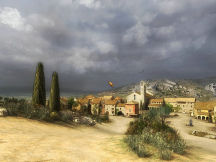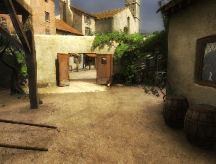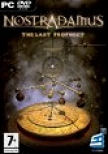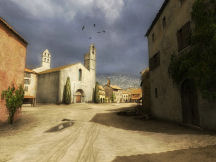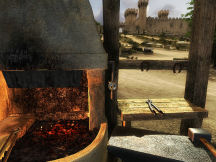Care for a murder mystery? Set in Renaissance France?
With a strong female protagonist who uses the science of that era to
pursue the murderer? Throw in a twisty plot, clever clues, and well
integrated puzzles. And out of this recipe you have -- Nostradamus: The
Last Prophecy.
Okay, where does Nostradamus fit in?
The year is 1566. A string of unsolved murders has followed Queen
Mother Catherine de Médicis to Salon de Provence. In this small French
town, Catherine is seeking advice from a friend and counselor -- the
famous Nostradamus. A prophecy has surfaced that fits the pattern of the
murders. It points to an all but unavoidable tragedy to befall the royal
family.
Nostradamus is too ill to begin an investigation himself. But he offers
Catherine the services of his son, César. The only drawback is that,
unbeknownst to anyone else, César is hundreds of miles away. Nostradamus
secretly plans to disguise his daughter Madeleine as César and allow
Madeleine to conduct the investigation.
This element of disguise, along with the game's emphasis on character
and dialog, made me feel as though I was playing an interactive historical
drama.
All the World's a Stage
Stepping into Nostradamus' gameworld is akin to entering a
Rembrandt painting full of soft shadows and glowing light. The settings
are packed with rustic detail and artistic touches. It's clear that a
great deal of historical research went into the game's development.
Although this is a compelling place to discover clues and unravel the
mystery, it is also a fairly restricted environment.
And All the Men and Women Merely Players
Madeleine, the protagonist, is one of the game's strongest assets.
She's lovely, strong-willed, smart and determined. Putting her in male
guise from time to time is vital to the plot and entertainingly shows how
other characters react to her dual personae. In an ironic twist, Madeleine
exhibits the self-assurance of a modern "liberated" woman, but comes very
close to fulfilling an ancient female role.
Nostradamus is physically frail, almost a prisoner to his own
infirmities as he moves from bed to chair on the second floor of his home.
He talks much less about the future than about practical strategies to
capture a possible mass murderer among the Queen's retinue. He uses his
knowledge of pharmacology and astrology, as well as what he knows about
the human spirit.
Members of Catherine's court and of the Church -- hangers-on looking
for status, power, money and (occasionally) knowledge -- also have roles
to play. Character animation is a bit stiff, but not so much that it
detracts from the game. Lip synch is acceptable. Gestures are subtle and
appropriate.
The Last Syllable of Recorded Time
Apart from a couple of mispronunciations, the game's English language
localization is very good. Dialog is rather formal, again providing
something of a theatrical tone. (Or perhaps this was common in the context
of a royal court.) Madeleine's thoughts are brief and to the point. Though
you interact frequently in order to advance the story, I would not
consider this to be a dialog-heavy game. (You can click quickly through
the dialogs using the space bar). The most "human" moments occur during
Nostradamus' tender asides to his daughter and in conversation with
Constance, the coquettish lady-in-waiting.
The gamer is given a small amount of historical information to flesh
out the story, the clues, and the last prophecy. I wish there had been a
lot more historical information. I ended up researching on my own
to provide a context for what was happening in the plot. It's possible
that more history is included in the game and I just haven't figured out
how to unlock it. But the experience would have been considerably richer
if I had found the historical information easily accessible in-game.
Music with Her Silver Sound
The voiceovers for the main characters are excellent. A couple of the
minor player voices are acceptable, if not distinguished.
The music in Nostradamus has a Renaissance flair, with a modern
twist. Strings are featured, accompanied by unusual background percussion
and (often) a clear soprano voice. The music sets the mood well, though
occasionally it's a trifle overdramatic and intrusive.
Ambient sounds are most effective at night, when you hear the roar of a
hearth fire, crickets and night birds calling.
The Play's the Thing
If you've played Echo: Secrets of the Lost Cavern or The
Secrets of Da Vinci: The Forbidden Manuscript -- both of which, like
Nostradamus, were designed by Marianne Tostivint of TOTEM Studio --
you will be right at home here. Nostradamus has a point-and-click
interface with 360 degree panning. Movement is easy and intuitive, with
one exception -- at times you'll need to drag an arrow using the mouse, a
particularly clumsy action. This was the only interface frustration.
The game features an extensive inventory, including a multi-functioning
logbook. Inventory items can be studied up close and modified using a kit
with the "latest" Renaissance tools. You can also use the tools to examine
the crime scenes and to actively explore the text and illustrations within
the logbook -- an elegant setup for cluing and puzzle solving. I recommend
reading the manual before playing the game to understand how things work.
The logbook records the dialogs. This is helpful when reviewing
conversations for clues, or for refreshing your memory after taking a
break from the game. The journal portion of the logbook contains a list of
tasks to be accomplished, which eliminates most of the
wandering-around-wondering-what-to-do vagueness often encountered in
adventure games.
Some puzzles provide ingredient lists for creating medicines,
cosmetics, potions and tasty dishes. I thoroughly enjoyed preparing these
concoctions in the game's Old World equivalents of a laboratory and
kitchen.
Crime scene examinations are conducted in close-up view, and often
require the use of the tool kit. Pixel hunting in the gameworld at large
is minimal, but some pixel hunting occurs within the close-up screens. A
timed challenge midway through the game can be tricky even after you've
figured out what to do.
Unfortunately, Nostradamus has a glitch that, if you fall prey
to it, becomes a dead end. I understand that a patch is currently in the
works to correct this problem. (To avoid the glitch, don't use two
different ropes for the same task at the chateau.)
At game's end you receive a point total. This encourages replaying to
best your previous score.
The Way to Dusty Death
A second timed challenge occurs near the end of the game. It's a
continuum of puzzles, one with concentric circles that have to be
(clumsily) dragged with the mouse, and one a code interpretation puzzle.
And then there's more timed inventory action once those are done. In these
final moments, Madeleine feels her life ebbing away -- and unless you're
quick, she dies repeatedly.
If you don't finish the whole sequence in time, the game puts you back
at the beginning without having solved anything. This means a lot
of repetition, though saving frequently (you can save at any point during
the sequence) does ease the repetition a bit. My prediction: unless the
timer for this sequence is made more generous, many people with slower
reflexes will have to ask for a saved game in order to reach the end.
This sequence was my least favorite part of the game. Still, from one
perspective I have no argument with it. At its crisis point, the story
really does require an intense atmosphere of danger and menace. Here was
risk and threat and tension, all combined into one. And when I did finally
complete the challenge, the resulting cut scene was startling enough to
(almost) be worth the work required to get there.
Oft Expectation Fails
My expectations for this game were particularly high, based on my
experience with previous games designed by Ms. Tostivint. There were
moments in ECHO: Secrets of the Lost Cavern and in The Secrets
of Da Vinci when I was enchanted by the originality of the puzzles,
intrigued by the clever way history intersected the game's plot, or awed
by the beauty of the music. I did not have these experiences in
Nostradamus, perhaps because I was anticipating them so much!
Nostradamus is well crafted and smooth. It never crashes, the
localization is good, the locales are authentic, the writing is solid, the
performances engaging, the puzzles blend well with the plot, and the story
holds the gamer's interest throughout. Still, somewhere, somehow,
something is missing.
In the end, I think what's missing has to do either with the lack of
nuanced, unconventional villains -- or perhaps with Madeleine herself. Our
heroine makes a wonderful Renaissance sleuth and the game expertly tests
and reveals her abilities. But Madeleine's personality doesn't seem to
develop in any way during the course of the adventure. Is it possible to
have the power to change your world and yet not be affected by the
process? I'd like to see more of Madeleine in other games, and I'd like to
see how her experiences have changed her.
Quick List for Nostradamus: The Final Prophecy
A murder mystery set in Renaissance France introducing a new adventure
heroine -- Madeleine, daughter of Nostradamus. I downloaded Nostradamus
via the online
Kheops Shop. The game will release on disk in early 2008.
Exceptionally beautiful graphics. An absorbing plot with plenty of
interaction, but without long dialogs. A surprise ending. First person
point-and-click, 360 degree panning. Good voiceovers, slightly stiff
character animations.
Puzzles are clever, varied and well integrated into the plot (some are
astrologically themed, many involve Renaissance era tools). Inventory
puzzles, code and pattern recognition puzzles, dialog based challenges.
One slider-like challenge, an auditory puzzle that hearing impaired gamers
can solve visually. No color based puzzles or mazes. Two particularly
difficult challenges -- a long, elaborate timed sequence in which you die
frequently, and a couple of pixel hunts in close-up screens. I recommend
reading the manual.
Installation was smooth. No crashes. One glitch that leads to a dead
end. (To avoid the glitch, don't use two different ropes for the same task
at the chateau.)
Nostradamus: The Last Prophecy is aimed at gamers who would like
to assume the role of a Renaissance era crime solver, and who enjoy
character-driven, twisty plots. Meeting the famous Nostradamus adds
intrigue to the mix.
Final Grade: B
My Computer Specs:
Windows XP Professional
Pentium 2.80 GHz
2046 MB RAM
Direct X 9.0c
512 MB NVIDIA GeForce 7800 GTX
SB X-Fi Audio
Section headings are quotations from the works of William Shakespeare
(1564-1616).
December 2007
design copyright ©
2007
GameBoomers
Group
